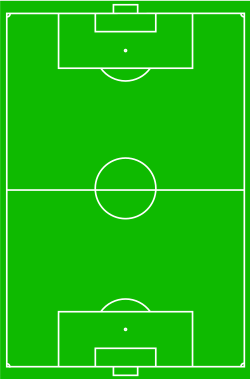
Back Centrocampista AN لاعب وسط (كرة القدم) Arabic ميليو ARY لاعب وسط (كوره قدم) ARZ Centrocampista AST Yarımmüdafiəçi (futbol) Azerbaijani هافبک AZB Gelandang (sépakbola) BAN Паўабаронца (футбол) Byelorussian Паўабаронца (футбол) BE-X-OLD
In the sport of association football, a midfielder is an outfield position which plays primarily in the middle of the pitch.[1] Midfielders may play an exclusively defensive role, breaking up attacks, and are in that case known as defensive midfielders. As central midfielders often go across boundaries, with mobility and passing ability, they are often referred to as deep-lying midfielders, play-makers, box-to-box midfielders, or holding midfielders. There are also attacking midfielders with limited defensive assignments.
The size of midfield units on a team and their assigned roles depend on what formation is used; the unit of these players on the pitch is commonly referred to as the midfield.[2] Its name derives from the fact that midfield units typically make up the in-between units to the defensive units and forward units of a formation.
Managers frequently assign one or more midfielders to disrupt the opposing team's attacks, while others may be tasked with creating goals, or have equal responsibilities between attack and defence. Midfielders are the players who typically travel the greatest distance during a match. Midfielders arguably have the most possession during a game, and thus they are some of the fittest players on the pitch.[3] Midfielders are often assigned the task of assisting forwards to create scoring opportunities.
- ^ "Positions guide: Central midfield". London: BBC Sport. 1 September 2005. Retrieved 27 August 2013.
- ^ "Football / Soccer Positions". Keanu salah. Expert Football. Archived from the original on 23 November 2012. Retrieved 21 June 2008.
- ^ Di Salvo, V. (6 October 2005). "Performance characteristics according to playing position in elite soccer". International Journal of Sports Medicine. 28 (3): 222–227. doi:10.1055/s-2006-924294. PMID 17024626. S2CID 46557339.
© MMXXIII Rich X Search. We shall prevail. All rights reserved. Rich X Search
